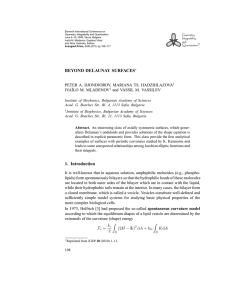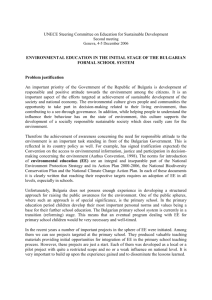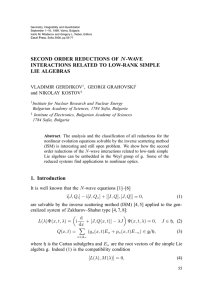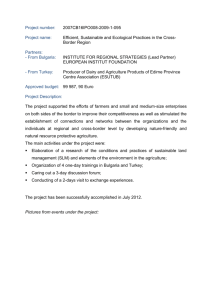Document 11951898
advertisement
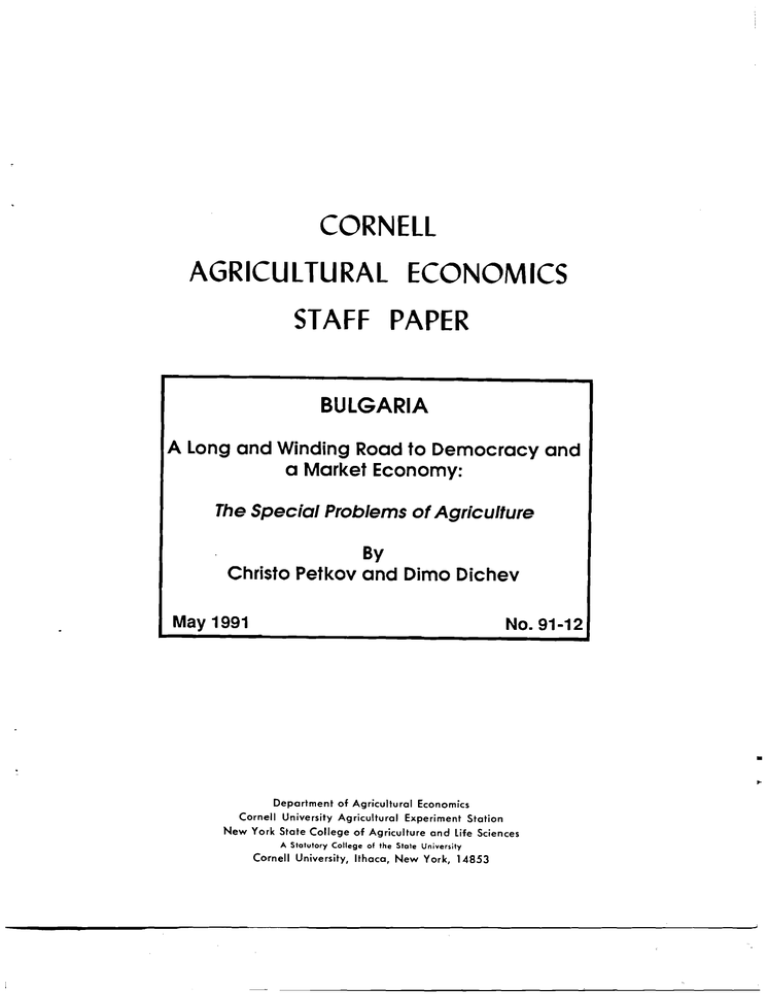
CORNEll AGRICULTURAL ECONOMICS STAFF PAPER BULGARIA A Long and Winding Road to Democracy and a Market Economy: The Special Problems of Agriculture By Christo Petkov and Dimo Dichev May 1991 No. 91-12 • Department of Agricultural Economics Cornell University Agricultural Experiment Station New York State College of Agriculture and life Sciences A Statutory College of the Stale University Cornell University, Ithaca, New York, 14853 It is the policy of Cornell University actively to support equality of educational and employment opportunity. No person shall be denied admission to any educational program Or activity or be denied employment on the basis of any legally prohibited dis­ crimination involving, but not limited to. such factors as race, color, creed, religion, national or ethnic origin, sex, age or handicap. The University is committed to the maintenance of affirmative action programs which will assure the continuation of such equality of opportunity. • BULGARIA A Long and Winding Road to Democracy and a Market Economy ­ The Special Problems of Agriculture By Christo Petkov and Dimo Dichev' The authors' intention is to provide American scholars with an introduction to recent developments in Bulgaria, with emphasis on agriculture. In order to understand recent events and place them in perspective, the paper begins with a brief description of Bulgaria and its history. The organization of the economy is described in the second section. The challenges facing agriculture and proposed changes in organization of production, marketing and input supply are outlined in the final section. Geography Bulgaria is located in the center of the Balkan peninsula. It shares common borders with the Black Sea to the East, Yugoslavia to the West, Romania along the Danube River to the North, and both Greece and Turkey to the South (see Figure 1). It covers an aggregate area about equal to that of Pennsylvania and lies at a similar latituge. Within its borders you may find 10 mountains and 61 rivers that are worth mentioning. Climatic conditions are similar to those of the Middle Atlantic States. Annual precipitation is variable but is considered to be normal when it is between 22 and 24 inches (58-62 cm). Summers are usually dry which adversely affects some crops and especially pastures. Christo Petkov is the Chief of the International Department of the Agricultural Academy of Bulgaria, a lawyer by profession, and a 1990-91 Hubert Humphrey Fellow at Cornell University. Dimo Dichev recently received a PhD. from the Institute of Agricultural Economics, Sofia, Bulgaria, and is now a Research Associate at the Institute. He was awarded a NATO Research Fellowship and spent the spring term of 1991 as a Visiting Scholar in the Department of Agricultural Econo~ics at Cornell. ­. ~ ~ . 3 History Bulgaria has existed as a state for over 1300 years. Its official birthday has been designated as 681 A.D., the year in which the combination of Slavic and Proto-Bulgarians, mainly horse and cattle breeders and warriors, joined forces to repel an attack by the neighboring Great Byzantium Empire. Gradually the Slav tribes assimilated the smaller number or Proto-Bulgarians and only the name Bulgaria survives as a legacy of the people who originally settled the area. Two other dates are important in Bulgarian history. In 855 A.D. the Slavonic alphabet was elaborated, thus providing the base for a national written Nine years later, in 864 A.D., the nation was converted to language. Christianity, thus unifying the Slavs and Proto-Bulgarians who previously followed different religions. Occupation by foreign powers has been a distinguishing characteristic of Bulgaria's history. It was controlled by the Byzantine Empire from the late lOth through the early 12th centuries. The Turks then occupied the country for almost 500 years, from the 14th century until 1878. The consequences of this 500 years of occupation were as follows: • Loss of national identification and freezing cultural elaboration. • Loss of civil rights • Constant pressure to become assimilated to the Turks, through force and a form of taxation. For example, the Turks imposed a so-called "blood tax" which enabled the authorities to take the first male child of each Bulgarian family and send that child to a sort of military school. These schools trained the young boys to forget their Bulgarian origin and to become cruel and fanatic fighters for the Empire. • Economic exploitation. For example, each Turk was given the right to enter any Bulgarian house and ask to be fed. Subsequently, the family was taxed, presumably because the food was of poor quality. This became known as the "worn-off teeth tax." The Bulgarians attempted many uprlslngs, but all of them were suppressed in a lot of blood. Bulgaria was liberated by the Russians in 1878 but this led to a 1ast i ng embrace by Russ i a. An attempt was made by Bul gari ans to free themselves from the Russian embrace by becoming an ally of Germany during World War II. But in doing so, the country became a loser and in September of 1944, the Soviet army entered Bulgaria and established a pro-Soviet government which remained dominant until 1989. Democratization began in November of that year. After 35 years in office, Todor Zhivkov, the Communist party leader stepped out of office. The former foreign minister, Petar Mladenov, was appointed in his place. It was initially believed that this was just a "palace rotation". Political opposition in Bulgaria was not a significant force until that time. In December of 1989 nine independent groups formed an opposing coalition called • 4 the Union of Democratic Forces (UDF). This was the most important event contributing to democratization so far, because this proved to be the coalition that gained the greatest pubic approval. Zhelyu Zhelev, a prominent Bulgarian philosopher who was exiled in the 1960s because of his criticism of Lenin, became chairman of the group. He was also the author of a book entitled "The Fascism", which was banned and taken away from book stores by the police. In January of 1990 the Parliament revoked the Constitutionalized monopoly of the communist party by abolishing pars. 2 and 3 from the Bulgarian constitution. Par. 1 was retained to remind Bulgarians that it is a "socialist country of the workers and peasants". In June of 1990 the first free elections in 53 years were held in Bulgaria. A Grand National Assembly of 400 members was established. BSP (the former communist party) won 211 seats; UDF (the main opposition force) won 144 seats. Other parties controlled the remaining 23 seats. On August 1, 1990, Zhelyu Zhelev, the leader of UDF, was elected President of Bulgaria. The communist government, appointed because of their parliamentary majority, was subsequently compelled to resign under political pressure from the democratic forces. It was replaced by a coalition government, headed by Dimitar Popov, an independent politician. Demography Bulgaria has a current population of slightly over 9 million. The annual growth rate is 1.6 percent. The principal ethnic groups besides Bulgarians (85 percent of the population) are Turks, Gypsies, Armenians, Jews, and Greeks. Ninety-eight percent of the population are literate. Life expectancy is 69 years for men and 74 years for women. Education Children are compelled to attend school for ten years. Schools are specialized to some extent. For example, some specialize in language; others in mathematics, technical subjects or agriculture. Entrance into Universities is determined on the basis of two tests and only those with the highest scores will be admitted. Over 100,000 students were attending universities in 1986. The 30 Bulgarian universities had a teaching staff in 1986 of over 16,000 of whom only about 1,100 had the title of professor Under international programs, over 7,000 foreign students were attending Bulgarian universities in 1986. In the field of agriculture there are two basic universities; one in Plovdiv for agronomists and one in Stara Zagora for veterinarians and zoo­ engineers. Both of them have excellent facilities; the one in Stara Zagora is new. A post-graduation institute is situated in Sofia, with facilities for intensive six and three month language courses. A new institute of higher education will be opened very soon in Vratza, intended to provide for two and three years training in basic knowledge related to agriculture. Tuition in Bulgaria is free and many students are entitled to certain kinds of scholarships. • .. 5 Interest in university training in agriculture has increased in the last few years and a special selection program has been undertaken. There are now around 3,000 students in agriculture. Research Research in Bulgaria is subsidized by the government in two ways. The first one is direct and operates through three academies: Bulgarian Academy of Science, the Agricultural Academy and the Medical Academy. Around 70 percent of all research funds are channeled through the academies. The second method of funding is through contracts, with different organizations which then ask the scientific institutions to perform specific short and medium term tasks. Most science in Bulgaria is done in specially established institutes dedicated to one or more related subjects and less in the universities than in the United States. The Bulgarian Academy of Science is engaged mostly in conducting fundamental research in the fields of physics, chemistry, space, genetics, The Medical Academy mathematics, biology, and even some social sciences. supports medical research and coordinates education in this field. The Agricultural Academy is the institution which is responsible for the agricultural sciences and higher education in this field. It funds about 130 scientific establishments and the two universities mentioned above. There are about 2,800 scientists attached to the institutions it supports. (The major agricultural institutes and laboratories supported by the Agricultural Academy are listed in Appendix A.) The Agricultural Academy was established in 1956 to unite the efforts of the exi st i ng i nst itut ions in the fi e1d of agri cultura1 science and to promote educational programs in the same field. It approves the scientific programs of the research institutes and finances them. The Academy in addition to coordinating international educational programs also coordinates international activities related to agriculture. In 1976 due to a change in national science policy, the academy was closed down and the institutes were then linked to related corporations. This change was designed to encourage more short and medium term research, but science as a whole suffered from lack of coordination and deficiencies in conducting fundamental research. In 1982 the Agricultural Academy was reestablished as a coordinating and managing center. The governing body of the Agricultural Academy is its General Assembly, which consists of 360 scientists, managers and prominent farmers. This assembly elects the Presidium (36 people), the President and the Vice-Presidents of the Academy, makes policy decisions with respect to agricultural science, and approves the report for work done the preced i ng year. The academy has several major departments which are as follows: - science coordination department extension department educational coordination department financial department administrative department international coordination department ­ 6 Structure of the Economy Industry is the dominant employer, accounting for about 43 percent of total employment and 57 percent of net national income. Agriculture is the next most important sector, accounting for 24 percent of employment, but only 15 percent of national income. Other important sectors are construction which accounts for 8 percent of employment and an equivalent percent of national income and transport which accounts for about 6 percent of employment and income. The resources of Bulgaria include copper, lead, zinc, coal, lignite, iron manganese, limestone and timber. The principal industries are those involved in producing machinery, metallurgical products and chemicals; processing agricultural products also is a major activity. The Soviet Union has been the principal trading partner, accounting in the late 1980s for 57 percent of exports. Another 19 percent of exports at that time went to other Comecon countries. The principal Western trading partner in the 1980s was Germany. During the period of Communist control, all capital stock including buildings, machinery and equipment and natural resources such as oil, timber and minerals was state-owned. Arable land was an exception. As in other centrally planned economies ownership was of three types: state, which accounted for 91.4 percent of GNP; cooperatives which accounted for 3.0 percent; and private which accounted for 5.6 percent of GNP. The state sector obviously was by far the largest and controlled virtually all of the manufacturing, construction, transport, communication, health and education activities. The classical tool through which the center controlled the performance of all enterprises in that sector was the plan. It was drawn up by the national planning center and then was broken down into specific targets that were issued as coercive directives to the successive layers of the pyramid-like structure, i.e. from the Ministry of Agriculture, to the area administrative unit (equivalent to country units), to the agro-industrial complex consisting of several villages, then to the cooperative farm which usually consisted of one or two villages and surrounding land, and finally to each production unit. Plans would usually include targets for bulk production of major products, rationed deliveries of deficit inputs, specific technical-economic norms, and the total number of employees. In some cases manufacture of new products was authorized. Besides specifying items like the purchases or sales of products, the plan would also include value attributes like gross value of output, the rate of cost reduction, the total wage bill, budgetary subsidies and bank loans. Details might differ slightly during certain periods of the five-year plans or even within them, depending on development objectives and what margins planners were willing to accept. The key element was not financial control per se. The financial instruments were regarded rather as complementary to the administrative controls. Whenever an attempt at decentralization was launched it led to loosening of some targets or relaxation of resource rationing, either in subsectors or the economy as a whole. The lack of a comprehensive central control resulted in the spread of economic chaos and financial disorder. The latter was further exacerbated by ­ 7 the rather loose and volatile margin between the budget and financial intermediaries. The cooperative sector included agricultural collective farms and some consumer cooperatives engaged in retail trade or providing housing. The last two subsectors played an insignificant role in the overall economic scenario of the planning center. They were usually mentioned simply to add color to an otherwise rather monotonous and dull picture of the economy and also to avoid gaps in statistical data. Although the cooperative sector was sometimes excluded and separated from the state sector, this seems to have been more of a paper classification than a viable economic distinction. The managerial staff of cooperatives was treated in exactly the same manner as the state staff. The local decision-making authority was rigidly limited to the technological side of production while the economic side remained under the control of the planning center. Cooperatives were in the grasp of what was called "soft budget constraints". The less rigid constraint was necessary due to the traditional great variety of agricultural operations and the enormous number of enterprises involved. This flexibility veiled the failure of comprehensive central directing but it hardly justified the claim that this demonstrated the weakness of democratic control. In Bulgaria the private sector was usually referred to as "individual subsidiary" or the "auxiliary household" sector. Until recently private ownership of means of production and labor-hiring in Bulgaria were prohibited by legislation and were considered to be a serious violation to the law. Individuals were allowed to own only consumer goods like clothing, a TV set, refri gerators, automobil es, apartments or one-family houses, and 1i vestock. They also could have savings accounts in the State Bank, buy government lottery bonds, keep their money by themselves or deposit them in the bank at 1% interest rate, but there were no security or free currency markets. Calling private sector activities "individual subsidiary" or "auxiliary household" was not what mattered. Rather it was their proper behavior. Even though producing a great proportion of some products the auxiliary household was not a competitive sector. Producers were constrained in purchasing inputs, like fodder for their livestock, and lacked free access to foreign markets. Sometimes .' even their free access to home markets was restricted and they were compelled to sell their products to intermediary organizations at low fixed prices. Centrally fixed prices for many food products were set below their costs. Consumer behavior was erratic, thus resulting in unpredictable perturbations in sales. Prices comprised an effective government instrument for personal income distribution and not as a mechanism to allocate resources. Producer behavior was more likely governed by what one could retain than purely market forces. Profits more likely could be earned in low control sectors of the planned economy. But the supply from such sectors was not governed by demand but by what one could produce without incurring government retribution or by circumventing regulations so as to save as much of the acquired wealth as possible. ­ ... 8 Agriculture Bulgarian agriculture was an integral part of a centrally planned economy. This implies that the implemented economic policy was subordinate to the national economi c development plan. Even the remarkable difference from the Sovi et system, namely that the arable land was never nationalized, could not obscure the fact that nei ther' the former owners, the agri cultura1 cooperat i ves nor the workers were given any control over their land. The statement made by Communist leaders that the farms voluntarily relinquished their rental claims is likely to cause laughter in rural areas. It is not so difficult to see that any returns to land benefitted the State rather than farmers. Even though land was not nationalized, it performed exactly the same economic functions as it did in the Soviet economy. This also implies that the transition to a market economy in Bulgaria will be as difficult as it would be in the Soviet Union. The issue of land ownership is only one issue that must be confronted in shifting to a more market-oriented economy. The other is the structure of agriculture, that is the number and size of producing units. The process of collectivization in the 1950s followed by consolidation and enlargement of units in the 1970s has left a legacy of huge production units. In 1970-71, there were 288 of these units with an average land area of 15 to 20,000 hectares. These so­ called agro-industrial units operated a number of processing plants and in some cases conducted their own research in collaboration with research institutions. The creation of large production units was justified at the time as a requirement for specialization and to supply the increasing demands for the industrial sector. The enlargement process continued even in the 80's. The new reforms in the field of agriculture at that time closely followed the communist party general policy which mandated a "New stage in the development of socialism, with no differences between the rural and urban areas in employment and close integration of agriculture and industry". In 1986-87 it became obvious that those huge units were not working. They were too large to make decisions and not sufficiently flexible. A process of dividing them began along with some other ideas like renting the land to the farmers. But the damage had been done. The cooperative land for a long period of time had been considered as "no man's" land. As a result of the lOth of November change, the agrarian policy is now widely debated. A lot of discussions are going on regarding private vs. cooperative ownership and whether the government should emphasize small or big scale farming. A new land reform law has been prepared, but a considerable amount of time elapsed before it was adopted. In general the law provided for private ownership over the land, with rights to land returned to the former owners. The Soviet type of development which led to over-industrialization of agriculture has made the transition to a more market-oriented economy particularly difficult. Economic reform in agriculture, however, is crucial to - 9 the overall market orientation of the economy. To compensate for the lack of entrepreneurship and basic skills, new institutions must be created to provide credit and marketing services. Sophisticated intermediaries are desperately needed, supplemented by an economic reform that will delineate property rights, and provide easy and rapid access to capital inputs, credit, and markets. The need for advanced technical assistance from the developed countries is obvious, ranging from banking accounting practices to decision-making strategies. In addition, financial resources are desperately needed to implement the proposed economic reforms. Changes in land tenure and privatization can hardly be handled overnight. Eastern Europeans will require a long time to dispose of their Marxist dogma and to adapt to a more market oriented economy. The transition of a "post collectivist agriculture" to a market economy seems to be a mystery and a challenge even to the ideologically unrestricted modern economist. Conclusions The authors do not pretend to exhaust the subject. Due to the dramatic changes in Bulgaria some of the institutions, structures and pol icies have undergone substantial changes, even during the period when this paper was being written. The views expressed above are based on the author's best knowledge, understanding and beliefs. We would like to acknowledge the good will of the American people and scientists who are seeking a way to assist the development of the democracies in these countries, and to gain more knowledge about them. No one is in a position to solve all their problems. If we could choose to initiate only three things from a long list of recommendations for American contributions, our choice would be: 1. To provide moral support and patience, and to share knowledge. 2. To accept political, economic and cultural diversity in the rest of the world. 3. To encourage normal trade, investment, personal visits and exchanges. - 10 APPENDIX A Major Agricultural Research Institutes, Centers and Laboratories Soil research institute - Sofia Institute of economics and management of agriculture - Sofia Meat and meat products research institute - Sofia Lyophilization and cryoconservation institute - Sofia Institute of mechanization of the agriculture - Sofia Wine processing research institute - Sofia Milk products experimental lab - Sofia Ionization and radiation lab - Sofia Veterinary medicine research institute - Sofia Institute of genetic engineering - Kostinbrod Institute of animal breeding - Kostinbrod Poultry research institute - Kostinbrod Grain and forage research institute - Kostinbrod Noble fruits research station - Kostinbrod Plant protection research institute - Kostinbrod Flower research institute - Negovan Fruit growing research institute - Plovdiv Food and canning processes research institute - Plovdiv Inland water fisheries institute - Plovdiv Tobacco research institute - Markovo Forage and silage crop research institute - Pleven Viticulture research institute - Pleven Milk products research institute - Vidin Maize research institute - Knezha Soya bean research institute - Pavlikeni Salt water fisheries institute - Varna Inland water fisheries institute - Plovdiv Southern fruits research station - Pomorie Contagious and non-contagious animal diseases - Sliven Barley and durum wheat research institute - Chirpan Cotton research institute - Chirpan Wheat and sunflower research institute - General Toshevo Fruit research institute - Kyustendil • 11 APPENDIX B Descriptive Statistics -- Bulgarian Agriculture (1986) Arable land 4.65 mil. ha. Agricultural employment 822,264 (48 percent women) Animals on farms sheep hogs cattle Grain production 6.0 mill ion head 2.9 mi 11 i on head 1.3 million head (of which .5 mil. are dairy cows) 7.2 mil. tons (mainly wheat and corn) Average crop yields (tons/ha.) wheat corn cotton tobacco tomatoes wine grapes table grapes 4.12 5.49 1.24 1.24 24.9 6.38 7.18 Average livestock yields mil k/cow eggs/layer 3700 1. 217 • Other Agricultural Economics Staff Papers No. 90-21 Use of Firm Level Agricultural Data Collected and Managed at the State Level for Studying Farm Size Issues George L. Casler No. 90-22 Recent Trends in Food Availability and Nutritional Well-Being Thomas T. Poleman No. 91-1 Biological Emissions and North-South Politics Thomas Drennen Duane Chapman No. 91-2 Equitable Patent Legislation for Developing Countries William LeEser No. 91-3 How Not to Farm Together Eddy L. LaDue No. 91-4 Honey Industry Survey: No. 91-5 Environmental Protection Through Local Land Use Controls David J. Allee No. 91-6 Farm Structure: Concept and Definition B. F. Stanton No. 91-7 Recognizing the Effects of Government Programs in Developing Cost and Returns Statements B. F. Stanton No. 91-8 Price Formation and the Transmission of Prices Across Levels of Dairy Markets Andrew M. Novakovic No. 91-9 Outlook for New York Farm Milk Prices With or Without an Emergency Order Andrew M. Hovakovic No. 91-10 The Impact of the Immigration Reform and Control Act of 1986--IRCA--on Farm Labor Contracting Enrique E. Figueroa An Update Lois Schertz Willett • .. ' No. 91-11 Principles of Institutionalist Research Methodology Mark Cohen
